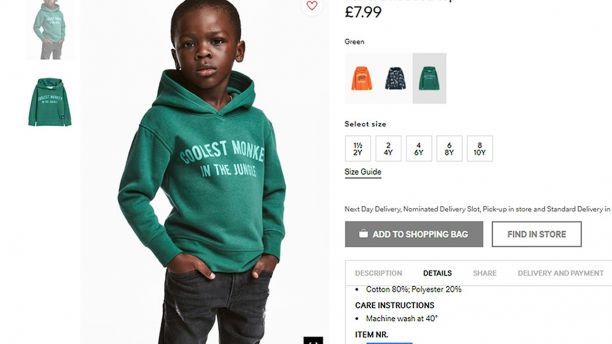
DeWinter Marketing RANT: H&M Monkey Shirt Scandal One of the Biggest Marketing Gaffes of the Year
I’ve covered a lot of Marketing RAVES lately: now I’m covering one of the biggest marketing gaffes of the year which was completely avoidable: the H&M Monkey Shirt scandal.
Here’s what happened:
Marketers & product developers at H&M, an international clothing company based in Sweden, completely lost all good judgment, approved a racist t-shirt, and started marketing it online.
This campaign featured a black boy in a sweatshirt that said: “Coolest Monkey in the Jungle.”
Every business owner’s dream is to have a campaign go viral, which this one did…but not in a good way.
Outrage and criticism of the sweatshirt was immediate and brutal. Social media erupted with a variety of “WTH” postings showing the black boy in the sweatshirt. Critics said the shirt was racist and tone deaf. What was particularly damning was that the black boy who modeled the sweatshirt was the only black model in the line of sweatshirts for youngsters, i.e. the black boy got the “Monkey in the Jungle” sweatshirt. The white models got other themes about being strong survivors.
Celebrities, social justice advocates, journalists and “average Joe’s” weighed in on the campaign. Twitter & Facebook were particularly active in spreading criticism. Everyone was amazed that a company based on Sweden with such an international customer base would fail to see the offensiveness of the campaign.
New York Times columnist Charles Blow said it best when he published this question to H&M:
“H&M, have you lost your damned minds?”
 Protestors in South Africa took it further.
Protestors in South Africa took it further.
They literally destroyed some H&M stores before police dispersed them with rubber bullets.
Marketing Gaffes Are Not As Easy To Bury In The Digital Age
In the old days of marketing, you could go quiet and dark to let something blow over. But that strategy doesn’t cut it in the age of social media.
Social media posts from consumers said “I’m not shopping at your stores any more.” Prominent musicians & artists cut their ties to H&M. Companies with cooperative marketing agreements with H&M also cut ties with the company to distance themselves from the controversy.
The story continued to build steam in late 2017, with H&M publicly apologizing on Jan. 8, 2018. They said they missed the boat, apologized, and went on to hire a diversity director.
What’s interesting about this is that H&M’s management and marketing team have not learned from their mistakes: this is not the first controversy the company has faced for racist campaigns.
- Exclusive White Models: In 2015, H&M South Africa was taken to task for showing mostly white models. When questioned about it, their PR statement said they wanted to convey “positive images,” i.e. white models are positive, black models are not.
- Ill-fated Head Dresses: In 2013, H&M started marketing an assortment of faux-feather head dresses, showing blue-eyed models showing off head dresses. Understandably, Native American peoples went on the warpath and said the product was offensive. H&M quickly removed the offending head dresses from its product offerings.
- Sweatshop Workers Killed: Also in 2013, H&M was using sweat shop labor to manufacture their clothing. A rickety building in Bangladesh in which the sweatshop laborers were working collapsed, killing 1,100 textile workers. H&M, Walmart & The Gap were among the companies using those sweatshop workers. They vowed to make changes and create better conditions. By 2016, nothing had been done.
H&M Marketing Gaffes Learning Points
There are multiple things to be learned from H&M’s mistakes:
Learning Point 1: LEARN from your mistakes. Every company’s going to have a mis-step at some point. But if you keep making the same mistakes, with the same blistering responses from consumers on social media, something’s wrong with management, and something’s terribly wrong in the marketing department.
Learning Point 2: Encourage feedback from team members. H&M admitted publicly that something had gone wrong in the vetting process for the racist Monkey in the Jungle sweatshirt. And I can tell you what it is. Someone came up with the idea. Some higher management person liked the idea, or thought it was funny. And no one had the cojones to come forward and say “The Emperor has no clothes on,” i.e. this is a very bad idea. The fact that no one stopped that sweatshirt from making it through the product development and marketing process points to some real problems. Management must not like criticism or concerns being aired. And employees clearly are not free to speak their minds. The management style is fear-based and that lead to yet another costly mistake and damage to the H&M brand.
Learning Point 3: Honor & Remember Your Brand. H&M is an international company with stores all over the world. Their brand is international. Even though they have stores operating in a variety of cultures, H&M marketing clearly forgot about their international brand and branding themes of celebrating diversity. The first step in branding is to define and develop your brand. The second step is to walk the walk and support the brand.
On a final note, what’s so stunning about these marketing gaffes from H&M is that they were completely avoidable. What H&M needed was a tenacious steward of the brand, who was not afraid to speak out, to be frank when encountering an offensive product offering, and to have the authority to put a stop to it. Clearly, this didn’t happen.
As a result, the H&M brand has paid dearly for its lack of common sense and for its lack of supporting its brand. In 2018, sales for this company are slumping. Stores are closing worldwide. The stock value has plummeted. As I said at the beginning, the H&M Monkey in the Jungle controversy was one of the biggest marketing gaffes of 2017, and it was completely avoidable. Ugh.
If you need help setting your brand, and MAINTAINING your brand, or to provide a sounding board for new products in development, please contact DeWinter Marketing & PR.

